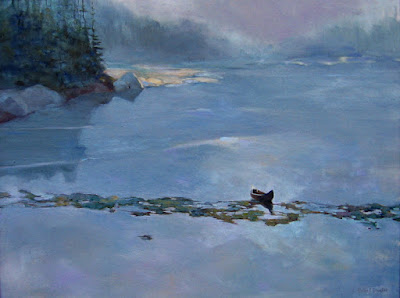At 5 PM today I’ll be participating in an artist’s talk on A Reflection on Water for Maine Farmland Trust Gallery. (It’s online, so feel free to sign up and heckle).
 |
| Beaver Dam, by Carol L. Douglas. Available through Maine Farmland Trust Gallery. |
People who don’t know me well are sometimes surprised to realize just how ‘green’ I am. I was raised along the Great Lakes in their worst years, when we couldn’t eat the fish or even swim in some places. I’m aware of just how much we humans are capable of fouling our own nests (or in the case of moving manufacturing offshore, fouling the nests of others). I’d prefer that we all consume less, and my family will tell you that I’m quite capable of hectoring on the subject.
I don’t paint didactically, however. I hope my work speaks to my awe at and respect for God’s Creation, but I’m not called to lecture with paint.
 |
| Fog Bank, by Carol L. Douglas. by Carol L. Douglas. Available through Maine Farmland Trust Gallery |
Water is a loaded and contradictory image. It is both the wellspring of life and its destroyer. Without it, life as we know it can’t exist. Christians are baptized with it; Jesus walked on it and turned it into wine. But on the flip side, water has great destructive potential. I only need to walk down to the harbor to see the power of the North Atlantic against seemingly-immutable granite. When God wanted to destroy civilization, he did so with a flood.
Why is water painted so frequently? Obviously, it’s beautiful and difficult to render in all its complexity. But it’s also a powerful metaphor for life. We humans are fragile vessels navigating seas that are sometimes serene, often tempestuous. In the end, no matter how many people we surround ourselves with, we sail alone.
 |
| Home Farm, by Carol L. Douglas. Available through Maine Farmland Trust Gallery |
Only one of the three paintings I have in this show is about the sea. In Fog Bank, water obscures our vision. That can be very dangerous here where the ocean and land intersect. In Home Farm, water has been tamed and collected for agricultural use by a prosperous farmer. In Beaver Dam, the watercourse has been altered not by man, but by wild beasts.
Last Saturday I potted around the Steinhatchee River in a pontoon boat with Natalia Andreevaand Mary O. Smith. It’s a short, pristine and very southern river. A large oak was down in the channel ahead of us; we were forced to backtrack and choose a different route. My hydrologist friend Ken Avery told me something interesting about these big snags in waterways: if someone doesn’t remove them, they will ultimately change the course of the river. That’s clear from looking at beaver dams, which are collections of fragile sticks that nonetheless alter streams forever.
 |
| Deadwood, 30X40, oil on canvas, by Carol L. Douglas. Available. |
It’s also a great life lesson and what I was trying to say in my painting Deadwood (which is too big for this show). Remove the detritus from your life or it will change the course of your existence.
I’ve been working so hard that my house is filthy, so I’m going to take the day off and use water—in a bucket, with a little Murphy’s Oil Soap—to do some fall cleaning. But at 5 PM sharp, I’ll be participating in an artist’s talk on A Reflection on Water for Maine Farmland Trust Gallery. (It’s online, so feel free to sign up and heckle). See you then.








